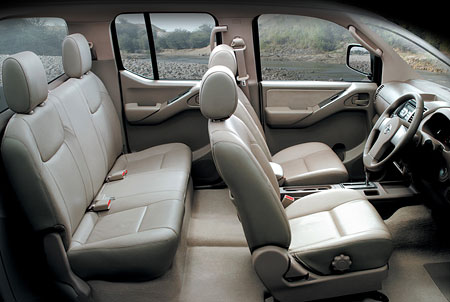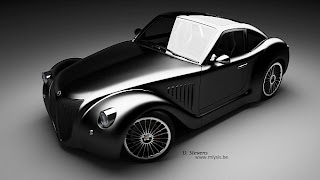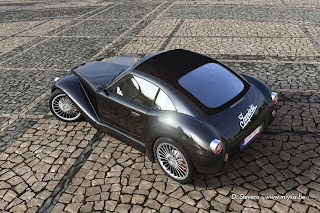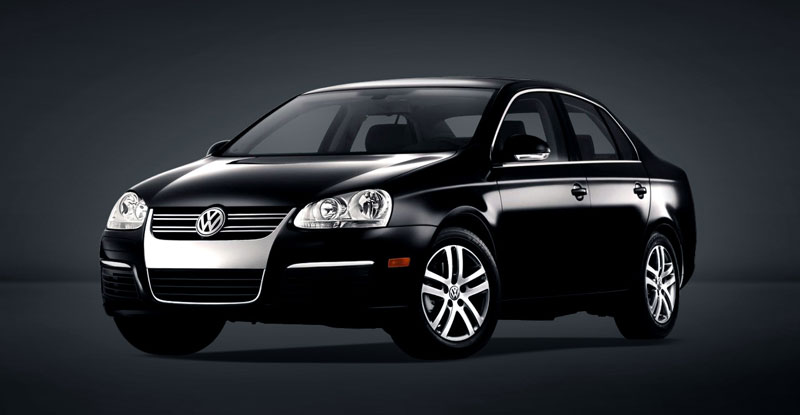
Nissan Frontier is the name for the D22 and D40 generations of Nissan pickup trucks in North, Central and South America and the Philippines. The line was started in 1998, and its immediate predecessor is the D21 Nissan Hardbody truck. As of 2002, the D22 series Nissan Truck is no longer sold in Japan, with the primary market having been relocated to North America, built at the Smyrna, Tennessee Nissan factory. Nissan was the pioneer of the Hardbody or Nissan Navara since 1986. The first was the D21, considered to be a small pick up. After more than 10 years with the D21, the second generation Navara was manufactured from 1998 and went until 2005 which was classed as a compact sized pick up. It was replaced with the bigger, taller, longer D40, which Nissan now considers to be a mid-size pick up truck. The Navara gets its name from the Navarre region of northern Spain, and the European version is built at the Nissan factory in Barcelona.

The Frontier was introduced in 1997 for the 1998 model year as a replacement for the aging 1986.5–1997 Nissan Hardbody Truck. Nissan first offered the Frontier with a 4-cylinder engine, the KA24DE, but added the V6 engine, the VG33E in 1999. Elsewhere, the Frontier was also known as the Nissan Navara That changed, with the introduction of the 2000 Frontier Crew Cab. The Crew Cab was the first compact pickup to offer a 4-door body-style in North America. Until that point, crew cabs were heavy duty versions of full-size trucks and were mainly used as commercial vehicles, although four-door compact pickups existed in Asia and Europe for decades. For 2001, Nissan facelifted the Frontier, introducing bolder styling in an effort to make it more appealing to younger buyers in its second generation. The Frontier was completely redone after the 2004 model year, which later resulted in the suspension of the regular cab model, indefinitely. Built in Japan from 1997 to 2000. Versions: Single cab, King Cab, Crew Cab (Introduced in 2000 and only available on 2000-current models). Engines: Petrol (KA24DE) and Diesel (TD27) (2wd and 4wd) with 5sp manual transmission. Also exported to Central and South America. US production in Tennessee started in 1998 with a Single cab and a King cab, a Crew Cab arrived in 2000. Also in 2000 a special edition was first offered called the Desert Runner. It had a king cab base but on the 4X4 frame which gave it a boost in ride height, bigger tires and a 4 speed 2WD drivetrain. In 2001 the Desert Runner got a new look and a supercharged version of the V6 engine.

The first Gen Frontier (2001–2004) was not sold or produced in Japan. Sales and production started in North America, with Crew Cab and King Cab versions and new grille, bumper, headlights, taillights, built in fender flares, and tailgates. Available engines include a petrol 2.4L, 3.3L, and a 3.3L Supercharged version 210 hp (160 kW). It is available with both 2 wheel and 4 wheel drive. The plant in Spain replaced production in Japan. They began exporting the second generation to Central and South America where it is called Frontier. Single Cabs and Crew Cabs are available with the Petrol or Diesel engines, 2wd and 4wd. Also in Australia and New Zealand. Brazil plant started production around 2002 (Crew Cab Diesel 2wd or 4wd, 5 speed manual, or single cab 2wd Diesel. Only for export to Mexico petrol 2.4 cc Built in Mexico) and export to Argentina (all Brazilians versions) and Mexico (Crew Cab, Petrol 2.4L, 2wd, Manual 5 speed). Egypt Plant export to Middle East, South Africa Plant to African countries. Mexico production, starting in 2008: D22 truck Single Cab Chassis and Long Bed (2wd or 4wd, Petrol 2.4L or Diesel, Crew Cab (2wd and Petrol) called D22 Pick up, Nissan Mexicana import from USA D40 Frontier V6.

Initially, the Frontier was considered a compact, but beginning with the totally redesigned model year 2005 Frontier (introduced at the 2004 North American International Auto Show), it became more mid-sized. It uses the new Nissan F-Alpha platform and exterior body styling resembles that of the company's full-size Nissan Titan truck. The new truck's wheelbase is 125.9 in (3.20 m) with a 205.5 in (5.22 m) overall length. Towing capacity is 6500 lb (2,950 kg). A 4.0 L VQ-family V6, the VQ40DE, is the standard engine, and it produces a respectable 265 hp (198 kW) with 284 ft·lbf (385 N·m) of torque. Also available is the QR25DE four-cylinder engine, which is also found in the Nissan Altima. A six-speed manual is standard with a five-speed automatic optional. Both rear and four-wheel drive are available. Traction control and hill-descent control are also available. The Frontier is called Navara when sold in Europe. The engine is a 2.5 L YD25DDTi diesel, with 142 hp (106 kW) or 172 hp (128 kW). The stronger version has 403 N·m (297 lb·ft) of torque. Suzuki has begun selling a Frontier-based mid-sized pickup that is produced by Nissan North America at the Smyrna plant.[8] The truck debuted at the 2008 Chicago Auto Show as the Suzuki Equator.[9] For 2009 the Frontier will get a face lift with more options, colors, and new wheels. The Nismo model will be replaced by a new PRO-4X model.

The Navara came with a 174 bhp (130 kW; 176 PS) (169 bhp (126 kW; 171 PS) engine on post September '06 vehicles with the introduction of the Euro IV compliant engine). It has four trim levels, the S, SE, Outlaw and Aventura. The Aventura trim package is equipped with leather upholstery, Dual Zone Climate Control, 6 CD/MP3 changer and satellite navigation as standard. In Australia, New Zealand and South Africa, the D40 Navara has a few differences from the UK versions. There are 2 engines available, 2.5 liter Turbo-charged Diesel engine and the V-6 petrol. The Diesel engine in 4WD models produces 128 kW (172 hp) at 4000 rpm and 403 N·m (297 lb·ft) at 2000 rpm, with the 2WD models producing less at 106 kW (142 hp) at 4000 rpm and 356 N·m (263 lb·ft) at 2000 rpm. The V-6 produces 198 kW (266 hp) at 5600 rpm of power and 385 N·m (284 lb·ft) at 4000 rpm of torque. Both engines come with a standard 5 speed Automatic, with a 6 speed manual available for the Diesel. These models do not have leather, climate control or satellite navigation system like their UK versions. The 2008 model of the Navara was launched on July 2. Changes included a new style of alloy wheels, bluetooth as standard, side work lights and indicators on the wing mirrors.

The 2008 Single Cab became available in Thailand since March 6. The 2.5 engine reduces the torque down from 356 N·m (263 ft·lbf) to 294 N·m (217 ft·lbf) @ 2,000 rpm. Using 15" wheels and exclusively reserved modified chassis. Power steering is standard, also available electric mirrors and central locking as optional extra. Nissan planned to sell the single cab and began to export worldwide at the same month. Nissan also continue to sell the D22 pickups with minor updates for a cheaper choice (now called as Frontier LCV). The Nissan Navara Double Cab became available in Malaysia on November 5, 2008. It is available with a 2.5L diesel engine producing 128 kW (172 hp) and 403 N·m (297 ft·lbf), only with a 5-speed automatic. A year later the 6-speed manual version is available. The D22 series Nissan Frontier remains on sale in Malaysia with a manual transmission. In November 2008 Nissan Thailand Released the all new Nissan Navara Calibre with a 144 PS (106 kW) @4000 rpm 36.3 kg·m (356 N·m; 263 ft·lbf) @2000 rpm available with a 5 speed automatic an a 6 speed manual transmissions. The Navara is not offered in Singapore due to the high excise duty for the pickup trucks there, and lack of interests.

Nissan has released the complete details and images of the 2010 Nissan Navara facelift along with the 2011 Nissan Pathfinder facelift. The 2010 Nissan Navara facelift are now powered by a new 3.0-litre V6 turbo V9X Engine diesel engine producing 240 hp (175 kW),406 lb-ft (500 Nm) @ 2,500 rpm and a revised 2.5-litre dCi unit(YD25DDTi High Power). The 2011 Nissan Navara and Pathfinder facelift V6 develop 170 kW (231 PS) and 550 Nm of torque between 1,700 rpm and 2,500 rpm an the famous YD engine which produces 190 PS (140 kW) and 450 Nm of torque an the VQ40DE remains the same with the 265 hp @5600 rpm; 291 ft·lbf (395 N·m) @4000 rpm. There are subtle changes to the headlights and the bonnet. The v-shaped grille shell is less pronounced and the bumper is rounder and projects 80mm further forward, but it's the six-spoke 17-inch alloy wheels or optional 18-inch alloy wheels that will be the plainest tell-tale to the new vehicle's identity.

Inside the new Navara (top of the line model), Nissan designers have specified softer materials of a better quality for the dash, seats and interior moulds. The centre console and fascia designs have been revised, as have the instrument binnacle layout and door trims. Additional bright/gloss finish surfacing is used throughout the cabin. The six-stack CD audio system or the TV Navigation entertainment console is upgraded with speed-sensing volume, MP3 compatibility and Bluetooth connectivity for the (six-stack CD audio system). Other new or revised features include dual-zone climate control, remote audio/Bluetooth/trip computer controls on the steering wheel, trip computer, external temperature gauge, speed-sensitive variable windscreen wipers and 'follow me home' lighting. The electric mirrors now fold in fully for car washes or parking in narrow spaces. Importantly, the upgraded Navara (diesel only) gains stability control—or Vehicle Dynamic Control to use Nissan's term for it—and all petrol V6 and diesel variants score side-impact and side-curtain airbags to complement the dual front airbags. Facelift for the South America, Asia/Oceania (except Australia), and the Caribbean models which is produced in Thailand will get it face lift later this year.























































